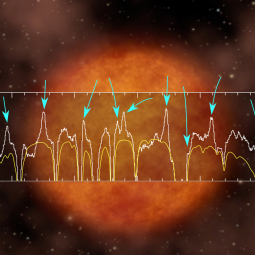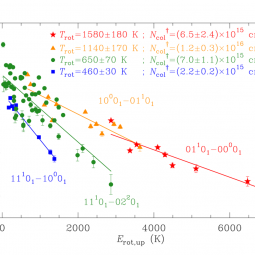By José Pablo Fonfría and Joan Schmelz
Paper:
Detection of infrared fluorescence of carbon dioxide in R Leonis with SOFIA/EXES
Fonfría, J. P., et al., 2020/11, A&A, 643L, 15.
The circumstellar envelopes of asymptotic giant branch (AGB) stars provide some of the richest chemical laboratories in space. Over 90 different molecules have been detected, most in the millimeter range where species with a permanent dipole often have strong transitions. Unfortunately, however, symmetric molecules like H2 lack such transitions. Another such molecule, CO₂, is predicted to be an abundant parent species for more complex organics. While CO₂ has been detected in AGB stars from space with low-spectral-resolution instruments on ISO and Spitzer, the extremely high atmospheric opacity makes it impossible to observe from the ground. For targets with suitable radial velocities, however, airborne observatories like SOFIA can use the Earth’s orbital velocity to Doppler-shift the astronomical lines away from the atmospheric obstruction, which is significantly reduced at a cruising altitude of 40,000 ft.
AGB stars are cool giants of 0.8–8 solar masses that have left the Main Sequence. After exhausting most of the hydrogen in their cores and triggering further nuclear reactions based on helium, these objects have seen a dramatic increase of their stellar radii that could be as high as 2–3 AU, a decrease of their effective temperatures down to about 2,000–3,000 K, and the formation of a significant amount of heavier atoms (e.g., C, O, N, Si, S). Moreover, these stars are variable with pulsation periods of months to years. The increased radius results in a weakening of the gravity at the stellar surface, allowing material to be expelled by the pulsation movement and radiation pressure. The expelled matter, initially in atomic form, cools to form a rich variety of molecules and dust grains. The analysis of the emission and absorption of these molecules offers valuable information to determine, for instance, the amount of ejected matter, the abundance of chemical elements produced by the star, and the chemical interactions between the ejected atoms in the circumstellar envelopes.
Carbon dioxide is predicted to be one of the most abundant molecules in the circumstellar envelopes of the oxygen-rich AGB stars, but because of the extreme observing difficulty mentioned above, the connection between the CO₂ abundance and the main characteristics of AGB stars is not well constrained. Furthermore, rotational temperatures of the circumstellar envelopes where the lines are formed can only be roughly determined from low spectral resolution data. Hence, it is difficult to compare these observations with results of currently available chemical models.
However, thanks to SOFIA, it was possible to get above most of the atmosphere and detect many lines of CO₂ in emission coming from the circumstellar envelope of the target star, R Leonis. The observed lines indicate that a very high fraction of CO₂ molecules are close to the photosphere and affected by the strong stellar continuum. Their emission is produced by infrared fluorescence, where molecules are excited to high energy levels by the stellar continuum in the near-infrared and de-excite afterwards in the form of radiative cascades.
The observations reveal a rich spectrum of about 240 identified CO₂ lines. Using excitation diagrams, researchers were able to separate the emission into three physical components with characteristic temperatures of 550, 1150, and 1600 K that they associated with gas at different distances from the central star. These high spectral-resolution data reveal a more accurate estimate of the CO₂ abundance in the layers of the circumstellar envelopes of AGB stars than previous space-based observations. The results not only enable refinements on the chemical networks and abundances, but also open up new challenges for the understanding of circumstellar-envelope chemistry. These observations of the CO₂ lines among the forest of atmospheric features would not have been possible without the high spectral resolution of EXES operating aboard the SOFIA airborne observatory.

